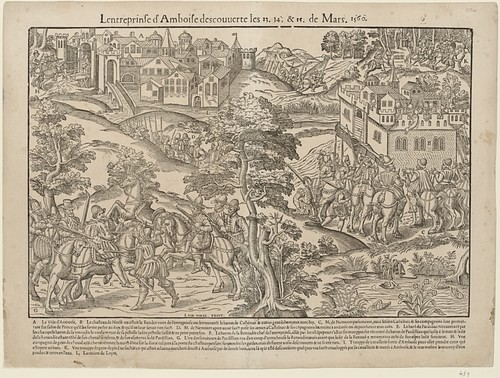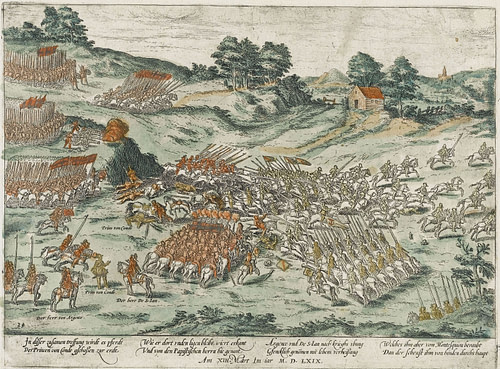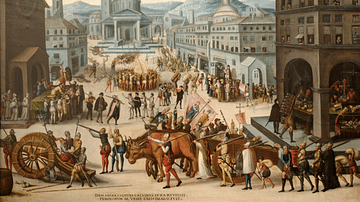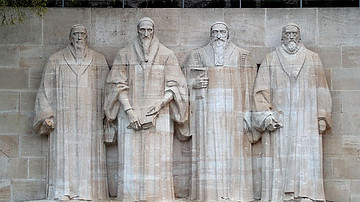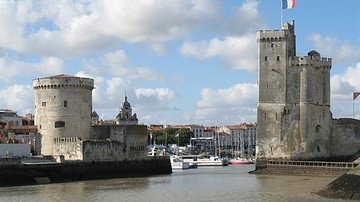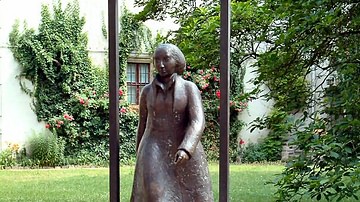
Louis I de Bourbon (l. 1530-1569) was a descendant of Louis IX of France (r. 1226-1270) and founder of the House of Condé. The Prince of Condé proved his valor as a Huguenot military leader during the first three French Wars of Religion and died at the Battle of Jarnac in 1569.
Historical Context
The Protestant Reformation disrupted the religious status quo of the early 1500s in Europe when multitudes embraced the teachings of Martin Luther (l. 1483-1546) and John Calvin (l. 1509-1564). Protestantism made gains in France among the nobility and commoners alike in the first decades of the 16th century and encountered opposition from the Catholic Church. By the mid-16th century, Protestants who followed the teachings of Calvin were known as Huguenots or Calvinists. Marguerite de Navarre (l. 1492-1549) protected Protestant leaders and supported reform efforts in the Catholic Church. She was the sister of King Francis I of France (r. 1515-1547), the mother of Huguenot leader Queen Jeanne d'Albret (l. 1528-1572), and the grandmother of Henry of Navarre (l. 1553-1610), who converted to Catholicism in 1593 to become Henry IV of France, the first Bourbon king. The Protestant challenge to the status quo of the Catholic Church in France eventually led to a bloody struggle between Protestants and Catholics during the French Wars of Religion (1562-1598).
The royal houses of France were often in competition and made alliances according to political expediency. Political intrigues, assassinations, and executions were never far from religious questions. The House of Guise, a minor offshoot of the Dukes of Lorraine, was the most ardent archenemy of Protestants. The Bourbons were princes of royal blood, but distant from the throne and with modest wealth. They were also viewed with suspicion since Charles III de Bourbon had plotted with Henry VIII of England (r. 1509-1547) and Charles V, Holy Roman Emperor (r. 1519-1556) to take up arms against King Francis I. Positions among the high nobility became clearly established with the all-powerful Guises on one side and the Bourbons on the other.
Early Life
Louis de Bourbon, a prince of royal blood, was the youngest son of Charles IV, Duke of Vendôme, and Françoise d'Alençon and was orphaned at an early age. He grew up under the care of Marguerite de Navarre and was introduced to the Reformed faith through his first wife, Eléanore de Roye (l. 1535-1564) with whom he had eight children. After Eléonore died in 1564, he married Françoise d'Orléans-Longueville, with whom he had three sons.
In the service of Henry II of France (r. 1547-1559), Condé stood out as a remarkable military commander. Together with Francis, Duke of Guise (l. 1519-1563), he retook Calais from the English in 1558, after a 200-year occupation. By 1562, Condé became one of the great Protestant leaders of France.
Conspiracy of Amboise
Upon King Henry II's death in 1559, Catherine de' Medici (l. 1519-1589) became regent to the young King Francis II of France (r. 1559-1560). Under the influence of the Guises through his brief marriage to their niece Mary, Queen of Scots (l. 1542-1587), Francis II signed a decree in September 1559 to destroy houses where Protestants gathered for worship. Protestants in major cities were arrested, and their possessions were confiscated. Nobles who came to the court to reclaim lost lands were turned away by the Cardinal of Lorraine, brother of Francis de Guise. As a result, Protestant nobles plotted to remove the young king from the influences of the Guises.
After the conspiracy of Amboise was unmasked and over 1500 conspirators executed, Condé was called before the king to defend himself against accusations of treason. There were indications of collusion between the conspirators and the princes of royal blood, but no solid evidence to indict them. Condé was indignant that anyone would suspect him and offered to duel his accusers. Nonetheless, he was forced to leave the court, and the Guises remained masters of the terrain. After the failed conspiracy, many Catholics considered the Huguenots seditious enemies of the kingdom who needed to be eliminated, while many Protestants considered the executed conspirators martyrs and sought vengeance.
Wars of Religion
When the Estates-General, composed of the clergy, nobility, and commoners, was convoked in Orléans in December 1560, the Guises took control of the city with thousands of soldiers. The royal princes fell into a trap and were insulted in the streets by soldiers. Condé was arrested, imprisoned, and condemned to death. The prince refused to answer Chancellor Michel de L'Hospital's questions and demanded to be judged by his peers. L'Hospital intervened to delay carrying out the death sentence against Condé. With young Francis II ill, Catherine was hesitant to kill Condé, which would place her at the mercy of the Guises. When Francis died in December 1560, Catherine became queen regent, and ten-year-old Charles IX of France (r. 1560-1574) became king. Condé's life was spared, and Catherine was now in the position to maneuver between the Bourbons and the Guises. She supported the Reformation in permitting Admiral Gaspard de Coligny (l. 1519-1572) and other nobles to hold prayer meetings in their apartments at Fontainebleau.
The Edict of January in 1562 under Catherine authorized Reformed worship in limited places. In provinces dominated by Protestants, Catholics did not understand the attitude of royal authority toward another religion. Now the objects of persecution, Catholics awaited the return of the Guises and met violence with violence, and Protestants were executed for the first time since Catherine de' Medici's arrival to power. Francis de Guise was the instigator of the massacre of Huguenots at worship in Vassy in March 1562, which commenced the First War of Religion. Condé took control of Orléans with a detachment of horsemen, and other cities rallied to him. Protestants held the Loire Valley, Dauphiné, the Rhône Valley, major cities in Normandy, Guyenne, and half of Languedoc. Catholic churches were pillaged, priests were attacked, and church bells were melted to make cannonballs. Condé's older brother Antoine de Bourbon (l. 1518-1562), commander of the king's troops, expelled all Protestants from Paris. Hatred toward him was so great that his family's tombs were desecrated and the remains dispersed.
Condé's officers returned to their provinces, and he felt abandoned at Orléans. In desperation, he sought foreign assistance from Queen Elizabeth I of England (r. 1558-1603). With the Treaty of Hampton in September 1562, Elizabeth promised her support of money and men in exchange for Le Havre as a pledge and the restitution of Calais after the victory. Francis de Guise and Antoine de Bourbon were both wounded during the battle to take Rouen. Antoine succumbed to his wounds, and Condé became the first prince of royal blood and Catherine's main rival. Condé prepared to march on Paris but met resistance south of Dreux from royal troops reinforced by German and Swiss troops recruited by Catherine. The Huguenot army engaged in a bloody battle and was severely beaten by the Constable de Montmorency and Francis de Guise. Condé was wounded and taken prisoner, and his army fled in disorder. In the place of Antoine de Bourbon, Francis was rewarded with his appointment as lieutenant general of the kingdom only to be assassinated a few weeks later at the siege of Orléans.
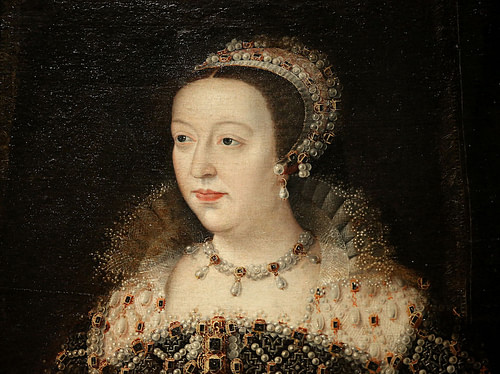
The edict of pacification of Amboise on 19 March 1563 ended the hostilities. Protestants obtained the freedom of worship in one city per district but were not permitted to construct new temples, and Protestant worship in Paris was forbidden. Nobles were allowed to worship in their homes, but only with their families and subjects. Admiral Coligny reproached Condé for his part in an edict that favored the nobles, and Catherine emerged triumphant in finally confining the Reformation to tolerable limits. The principal leaders of the rebellion were dead, aged, or discredited, but with Protestant armies controlling half the kingdom, the struggle was far from over.
Catherine persuaded Condé and Coligny to break with Queen Elizabeth, and with Condé's assistance, Protestants and Catholics united behind Catherine to retake Le Havre from the English in July 1563. Condé enjoyed life at court until his withdrawal after being publicly insulted by the teenage Duke of Anjou, the future Henry III of France, who claimed command of the army. Coligny was solicited to lead a plot to snatch the young King Charles IX, and when the plot was discovered, the king was taken to Paris under the protection of Swiss mercenaries.
Condé and Coligny sought negotiations with the court and presented their grievances. They requested the dismissal of the Swiss mercenaries, the removal of the Guises from power, and authorization for Protestant worship to no avail. Skirmishes broke out between royal forces and Condé's troops. Although Italian and Swiss troops reinforced the royal army, Catherine feared that they would be no match for the Protestant troops now numbering 30,000. She negotiated a truce with Condé at Longjumeau in March 1568 to end the Second War of Religion. The Treaty of Longjumeau lasted only six months and merely re-established the Edict of Amboise. Charles IX agreed to pay the Swiss mercenaries conditioned on their immediate withdrawal from the kingdom to avoid further pillaging. The king was humiliated by his forced return to Paris and dreamed of revenge against his Huguenot antagonists. Another war was on the horizon.
Death
Condé and Coligny, surveilled by the queen's agents day and night, escaped from Paris in August 1568, and in September, he arrived at La Rochelle, a Protestant stronghold of the French Reformation. There they found Jeanne d'Albret with her teenage son, Henry of Navarre, and troops from Gascony. They were joined by troops from Brittany and more than 20,000 recruits from southern France. The Third War of Religion broke out in September 1568, and in March 1569, the two armies met face-to-face on the banks of the Charente River at the Battle of Jarnac. Condé was attacked by mercenaries and royal troops and broke his leg falling from his horse. He surrendered and was shot in the head by an officer of the Duke of Anjou who paraded Condé's body on a donkey.
Coligny escaped to La Rochelle, where Jeanne d'Albret presented two new Huguenot leaders, her son Henry and her nephew Henry, the teenage son of Condé. The Huguenot army had two new royal princes at their head. The rivalry for the throne between the Guises and the Bourbons lasted for decades and intensified when the Valois dynasty ended with the assassination of Henry III of France (r. 1574-1589).

